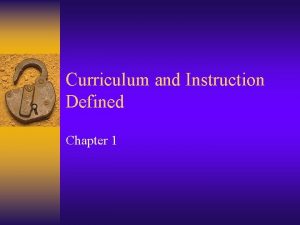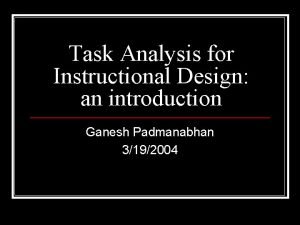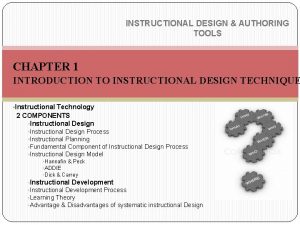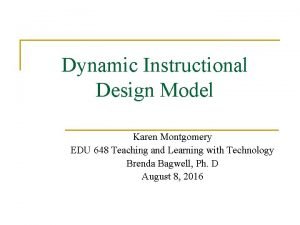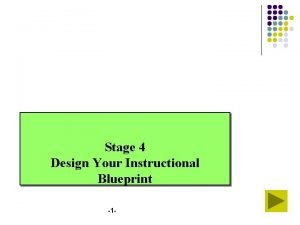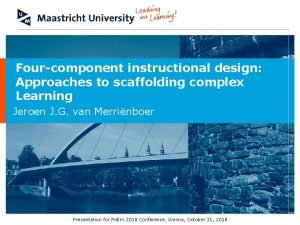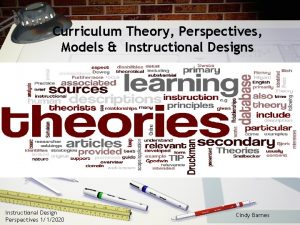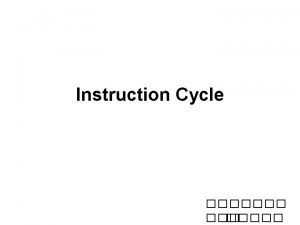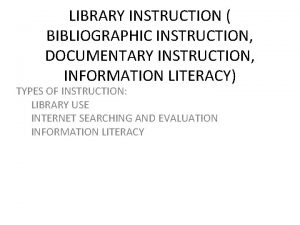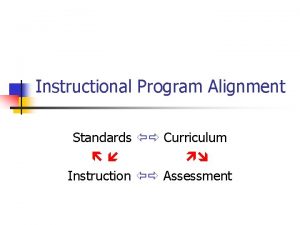Online Instructional Design Online Instructional Design Models Instruction












- Slides: 12

Online Instructional Design

Online Instructional Design Models • Instruction design has a vital role for a high-quality e-learning process. Behaviourism and Cognitivism Constructivism teacher- or expertcentred instruction student-centred approach

Online Instructional Design Models • There are many instructional design models, among which ADDIE, ARCS, Dick and Carey, and ASSURE are the commonly accepted ones.

Online Instructional Design Models for e-Learning: ADDIE • The most common used instructional design model for e-learning environment is the ADDIE model. Evaluate Analyse Implement Design Develop

Online Instructional Design Course Design for e-Learning: How Do We Do It? • Basic Rules for Instructional Design Systems • The components of a good instructional system are student, content, method, material, environment and technology. These components should be in harmony and interaction in order to provide a high-quality learning experience. Plus, the system should also be regularly assessed, and unsuccessful parts, if there any, should be improved upon to achieve an effective instructional process.

Online Instructional Design Course Design for e-Learning: How Do We Do It? • The Components of Planning Process Learners Content Learning Environment Instructional Approaches & Media

Online Instructional Design Course Design for e-Learning: How Do We Do It? The Components of Planning Process • Learners: Instructors should try to know and understand learners and their characteristics as much as possible. • Content: It is important to identify the learning objectives and to plan the course on the basis of these objectives. • Instructional Approaches and Media: Selection of the media most appropriate to the type of content, and selection of the most appropriate approach to deliver the content will ensure a more efficient learning process. • Learning Environment: Planning of the learning environment should be made on the basis of a careful review of the existing technological infrastructure and other technical issues such as any existing communication tools, learning management systems, and the available access speed.

Online Instructional Design Course Design for e-Learning: How Do We Do It? • Syllabus • Detailed information should be provided while planning an e-course in the form a syllabus. This information can be categorised under five main titles: Course Information Rules and Regulations Instructional Activities Evaluation Other Information

Online Instructional Design Course Design for e-Learning: How Do We Do It? • Learning Activities for Online Learning Environments • There are numerous activities for online learning environments. It is important to become familiar with them in order to select the right one. Moodle LMS provides instructors with such activities so as to enable learner-learner, learner-teacher or learner-content interaction.

Online Instructional Design Roles and Responsibilities During e-Learning Process • Content Development Process • Members of the content development team may include a research and design coordinator, content/subject matter expert, instructional designer, interface designer, copyright coordinator, evaluation specialist, production coordinator, programmer, editor, graphic designer, multimedia developer, video/photographer, learning objects specialist, quality control expert, and support staff.

Online Instructional Design Roles and Responsibilities During e-Learning Process • Content Delivery and Control Process • The content development process is followed by the implementation process. There are different experts in this process responsible for delivery of the content, sustainability of the delivery, and coordination of the whole process. Delivery of the content, in fact, constitutes the most important part of the elearning process.

Online Instructional Design Conclusion • Instructional design plays a crucial role in providing more effective, more efficient and higher quality learning experiences. • This is particularly important in online learning environments where interaction among learners, instructors and content is ensured through information and communication technologies instead of face-to-face means. • E-learning organizations should allocate sufficient time as well as financial and human resources for a detailed, well-planned, and effectively conducted content development stage to be followed by a systematic content delivery and control process based on collaboration, cooperation, and teamwork.
 The diamond model of curriculum development
The diamond model of curriculum development Individualized instruction vs differentiated instruction
Individualized instruction vs differentiated instruction Site:slidetodoc.com
Site:slidetodoc.com Dualistic model of curriculum
Dualistic model of curriculum What is the difference between model and semi modal
What is the difference between model and semi modal Task analysis instructional design
Task analysis instructional design Instructional design authoring tools
Instructional design authoring tools Dynamic instructional design model
Dynamic instructional design model What is assure model
What is assure model Madeline hunter lesson cycle
Madeline hunter lesson cycle öğretim tasarım modelleri
öğretim tasarım modelleri Qim far lab
Qim far lab Scaffolding instructional design
Scaffolding instructional design



